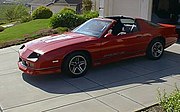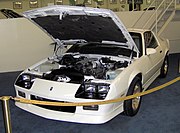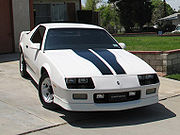Third-generation Chevrolet Camaro
| Third-generation Chevrolet Camaro | |
|---|---|
 | |
| Manufacturer | Chevrolet |
| Parent company | General Motors |
| Production | 1982-1992 |
| Assembly | Van Nuys, California Norwood, OH 1982-1987 only |
| Predecessor | Second–gen Camaro |
| Successor | Fourth–gen Camaro |
| Class | Pony car Muscle car Sports car |
| Body style(s) | 2-door coupé 2-door convertible |
| Layout | FR layout |
| Platform | GM F platform |
| Related | Pontiac Firebird |
The third-generation Chevrolet Camaro was introduced for the 1982 model year. It continued to use General Motors' F-body platform and would produce a "20th Anniversary Commemorative Edition" for 1987 and "25th Anniversary Heritage Edition" for 1992. These were also the first Camaros with factory fuel injection, four-speed automatic transmissions, five-speed manual transmissions, four-cylinder engines, 16-inch wheels, and hatchback bodies.
The third-gen Camaros would continue through the 1992 model year.
1982
The 1982 model introduced the first Camaros with factory fuel injection, four-speed automatic transmissions (three-speed on the earlier models), five-speed manual transmissions (four-speed manual transmissions in 1982, and some 1983 to 1984 models), 14 or 15 in (356 or 381 mm) wheels, a hatchback body style, and even a four-cylinder engine (due to concerns over fuel economy in the wake of the 1979 energy crisis). The Camaro Z28 was Motor Trend magazine's Car of the Year for 1982. Three models were available: Sport Coupe, Berlinetta, and Z28. Third generation Camaros also had a suspension system that was more capable in corners than the previous generation.
The Sport Coupe came standard with the 2.5 L 151 cid LQ9 four cylinder engine. The 2.8 L 173 LC1 V6 and 5.0 L 305 LG4 V8 were optional. Dog dish-style hub caps were standard; wheel covers were optional as were steel, five-spoke 14x7 body-colored rally wheels.
The Berlinetta came standard with the 2.8 LC1 V6 or the optional 5.0 LG4 V8. The Berlinetta came standard with its own unique 14x7 finned aluminum wheel with gold accenting and `Berlinetta' center cap. Its own lower body pinstriping, gold "Berlinetta" badging, and headlamp pockets were painted in an accent color. The tail lights got a gold and black horizontal divider bar. The interior came standard with custom cloth interior, a rear storage well cover and additional carpeting on rear wheelhouses. It also came standard with additional body insulation and full instrumentation.
The Z28 came standard with the 5.0 LG4 4bbl V8 or the optional LU5 twin TBI `Cross Fire Injection' 5.0 L. The carbureted engine was available with either a four-speed manual or three-speed automatic transmission and put out a "milquetoast" 145 hp (108 kW), while the optional Cross Fire Injection 305 was rated at 165 hp (123 kW). Performance enthusiasts of the day gave the new Camaro rave reviews for its styling and handling, but also made critical remarks about the relatively low power ratings and lackluster performance compared to Ford's Mustang GT, with the Blue-Oval's High Output 302 cubic-inch V8 and Top-Loader four-speed manual transmission.
All Z28s came with lightweight fiberglass SMC hoods with functional hood air induction flaps on RPO LU5 cars. The Z28 had a different nose, a three-piece rear spoiler and front, side, and rear lower body valances in silver or gold. Just above the valance was a two-color lower body stripe that encircled the car. Headlamp pockets on the Z28 were black. Standard were new 15x7 cast-aluminum five-spoke wheels accented with silver or gold. Z28 badges appeared on the right rear bumper, and on the side valances.
The Camaro Z28 paced the Indianapolis 500 in 1982, and over 6000 replicas were sold through Chevy dealers. The pace car edition featured special two-tone silver/blue paint and special striping, orange pin-striping on 15-inch Z28 wheels, and a silver/blue interior with six-way Lear-Seigler manually-adjustable seating. Engine choices in the pace cars were the same as the regular Z28. However, the car that actually paced the event was equipped with a highly modified all aluminum 5.7 L V8 not offered publicly, although there are rumors that four were actually produced.
1983
The Camaro had a significant change in the Z28 engine lineup: the lackluster and trouble-prone LU5 Crossfire 305 V8 was replaced shortly after the start of the model year by an all-new simpler 5.0 L L69 4 bbl 190 hp (142 kW) High-Output (HO) V8, giving the Z28 a much-needed power boost to be competitive with the competing Mustang GT. Only 3223 L69 V8s were sold in 1983, making one in good condition a rare find today. The base coupe and Berlinetta carried on as in 1982 with very little change other than new available colors
1984
The dashboard features becomes smaller and sharper because of complaints about the design quality and look. In the Berlinetta, the design was replaced with 'Star Wars-style' electronic instrumentation, including bar-graph tachometer and digital speedometer. The car has an overhead console and a pod-mounted controls for controls for turn signals, cruise-control, HVAC, windshield wiper and headlights.
Drivetrain changes include discontinuation of the 305 Cross Fire V-8, hydraulic clutch linkage on manual cars, and 700R4 automatic (overdrive) transmission replacing the previous 3 speed auto.
The L69 H.O. Z28 became available with automatic transmission.
A special order Corvette Handling Package (Code F41) was also made available this year only.
Road & Track selected the 1984 Camaro/Firebird as one of twelve best cars in the world and in the Best Sports GT category in the $11,000 to $14,000 range. Car and Driver picked the '84 Camaro Z28 as the best handling car built in the United States.
1985
For 1985, Chevrolet introduced a new Camaro model — the famous IROC-Z, named after the popular competition International Race of Champions. The Camaro IROC-Z featured an upgraded suspension with lowered springs, specially valved shocks, larger diameter sway bars, a special decal package, and an optional Tuned Port Injection system taken from the Corvette. It also shared the Corvette's 245/50ZR16 tires and new aluminum 5-spoke 16" wheels. The Camaro IROC-Z was on Car and Driver magazine's Ten Best list for 1985. The 305 was the only engine to receive Tuned Port Injection considering the L98 350 was not available until mid-year 1986; rated at 215 hp, it was available only on the IROC-Z model with the 700-R4 automatic transmission. Also new for 1985, all Camaros featured refreshed noses and new, deeper valances and front spoiler for the Z28 and the newly introduced IROC-Z28. The speedometers no longer had the unique double-pointed needle that simultaneously read mph and km/h: they were replaced by conventional single-pointer 85 mph (137 km/h) units. The 2.8 V6 became fuel-injected, raising power from 112 hp (84 kW) to 135 hp (101 kW). This would also be the final year for the less popular base-model 2.5 L 151 cid 4-cyl engine.
1986
A newly required Center High Mounted Stop Lamp (CHMSL) was installed on the Camaro. 1986 was the only year to see this attached to the hatchback glass on base model Sport Coupes, Z28s and IROC-Zs; in 87, it was in the same spot, but under the glass instead of on top of it. In following years it was implemented in the rear decklid spoiler, except for 1987 base models that did not have a spoiler. This was the final year for the L69 5.0 305 HO 4bbl option, and the 2.8 L V6 was now the standard engine in the base model - no more 4-bangers. The TPI 305 dropped from 215 hp (160 kW) to 190 hp (142 kW) in the Iroc-Z models. Chevrolet supposedly did build 75 IROC-Zs with the L98 5.7 L 350 TPI engines, but these cars were not equipped with A/C and not believed to be sold to the general public because they were test vehicles.
1987
The 350 TPI and 5 Speed 305 TPI combinations were finally available on the IROC-Z28 after a lot of testing although the 350 was only available in the IROC-Z and only with an automatic transmission, testing had proven that the 5 speed couldn't handle the greater power output of the TPI 350. The TPI 350 motor was not visually distinguishable from the TPI 305. Automatic and Manual 305 TPI got a 215 hp (160 kW) rating. Roller lifters and new valve cover/head design on V-8 Camaros. Valve covers featured new sealing and center bolts in the valve covers. Heads featured new raised lip for improved valve cover sealing. G92 and L98 (B2L) cars finally got the Borg-Warner HD 7.75 inch four pinion rear end, produced for GM Holden's Limited of Australia (Firebird WS6 cars went to this unit in 1986). These units can be identified by their 9 bolt (rather than 10) differential cover that has a rubber plug. The Borg-Warner logo is also cast into the bottom of the differential case. This rear axle came with tapered rather than straight roller bearings and a cone-clutch rather than disc-clutch limited slip unit. These units came painted black from the factory while most others were bare metal. All 1987 350 TPI (B2L) IROC-Z's required J65 rear disc brakes, G80 limited slip differential, and KC4 engine oil cooler. The largest visual change this year was the CHMSL was now mounted on the rear spoiler instead of atop the rear hatch (unless it was a base coupe without the spoiler option - on those it remained atop the hatch like last year). The Berlinettas were no longer available this year, replaced (ironically) with a new LT model, but the base and Z28s continued as before. 145 mph (233 km/h) speedometers became standard in the IROC-Zs and Z28s, the base and LTs got a new 110 mph (180 km/h) unit. The 2.8 V6 and 5.0 carbureted V8s carried on with no changes.
Other big Camaro news was a Camaro convertible that was introduced for the first time since 1969 as a regular production option. Available on the Sport Coupe and IROC-Z, the conversion was performed on t-top equipped (t-top models have extra bracing) Camaros by ASC. Only 1,007 were produced in the first year of production. 1987 marked the 20th anniversary of the Camaro and the convertibles were considered the anniversary editions and were signified by a special dash badge that read "20th Anniversary Commemorative Edition". Some 1987 T-Top models were made into convertibles by ASC after the customer took delivery. This is why there are some convertibles with the body VIN code of 2, meaning they were coupes, not convertibles (which have a body VIN code of 3). This was also the last year of production at GM's Norwood, OH facility as sales continued to decline therefore resulting in production reduced to the Van Nuys assembly plant located in Southern California.
1988
The Camaro line was greatly simplified this year, starting with discontinuing the slow-selling one-year-wonder LT model, and dropping the base Z28. All that was left was the base coupe and the IROC-Z, although the IROC-Z was decontented this year to compensate for the loss of the base Z28 - for example, the previously standard aluminum 16" 5-spoke wheels were now an option - "base" IROCs now got the old Z28's steel 15" 5-spoke wheels(which also became standard on the base coupes). Also the old Z28's ground effects and spoilers were now standard issue on the base coupes. Base models got a new raised spoiler on some models. All engines were fuel-injected this year, the 5.0 L 305 cid V8 gained throttle-body injection, bringing net horsepower to 170;the 2.8 V6, the 305 and 350 TPI engines carried on as before. G92 (performance axle ratio) available only on IROC-Z with 5.0 TPI (LB9). G92 was available on IROC-Z convertible in 1988. All 1987 350 TPI (B2L) IROC-Z's came standard with the 3.27 BW rear end and everything that was included with G92 but did not have the G92 RPO code because it was mandatory; this changed in 1988 however when a 2.77 BW rear was standard and G92 had to be specified to get the 3.27's.
1989
1989 signified the return of the RS designation (last used in 1980). The Rally Sport was now the base model featuring body ground effects mimicking the IROC and the previous Z28. They had the 2.8 V6 fuel injected motor as standard with the 5.0 305 LT1 as an option. The raised rear spoiler that became available in 1988 on the base coupes was short-lived and done away with for this year. The IROC-Zs were still available with the 170 hp (127 kW) TBI 305, 215 hp (160 kW) TPI 305, or the 400 hp (298 kW) TPI 396. IROCs had a new dual-converter option that boosted hp to 240 that was available only with the TPI 350 (and mandatory 700-R4 automatic). Also during this year all camaros were outfitted with the vats/passkey security system.
1990
1990 was the year with the lowest production to date (35,048), due to a truncated 1990 model run followed by early introduction of the facelifted 1991 models. 1990 also marked the final year for the IROC-Z. Chevrolet had decided not to renew their contract with the International Race of Champions, which was later renewed by Chrysler's Dodge Daytona. This year was the first year for an airbag to be offered in any F-body. The 2.8 L V6 was upgraded to the 3.1 L V6. Also, this was the first year for the updated "half-moon" gauge cluster that was offered only in 1990-1992 Camaros. That would make 1990 a distinguishable year by the fact it was the only 3rd gen Camaro that didn't feature the "aero" GFX but did feature the half-moon cluster.
1991
Early in 1990, the 1991 Camaros debuted. Big changes occurred, as all Camaros received a facelift in the form of a ground effects package for both the RS and Z28 models, while the IROC-Z was no longer offered. The Z28 also featured a high rise spoiler and non-functional hood "blisters". The 1991 Z28 also received a new wheel design to accent the new body accents. This was the first year that the B4C "Special Service" option was made available to law enforcement, the government, and military agencies. The B4C amounted to little more than a Z28 powertrain and suspension in the RS. (Car Craft Magazine refers to the B4C as a 1LE equipped with air conditioning.) Just under 600 B4C Camaros were sold for 1991. 1991 was also the first year that Z28 Camaros equipped with the 305 TPI motor and a manual transmission had the same roller cam profile as the 350 TPI motor. Power ratings on the 350 TPI were as follows; 250 hp (186 kW) @4400 rpm and 345 lb·ft (468 N·m) @3200 rpm. Power rating on the 305 TPI motor were as follows; 235 hp (175 kW) @4200 rpm and 300 lb·ft (410 N·m) @3200 rpm. Rumors say that these numbers were a little under rated by GM, but this has not been investigated.
1992
1992 was the final year of the third generation Camaro. A "25th Anniversary Heritage Edition" option had been planned with Corvette aluminum cylinder heads, tubular exhaust headers, and 6-speed manual transmission, but this was scrapped in favor of an option which amounted to nothing more than a graphics package of badges and rally stripes. The Camaro B4C got the addition of 1LE brakes and suspension, making it one of the best performing third generation Camaros. Just under 500 B4Cs were sold. The B4C option was also deemed popular enough to be carried on to the next model. 1992 Z28s also received some of the "left overs" from its Corvette cousin. Some received the cast aluminum style intake runners from the Corvette instead of the regular Camaro smooth tube ones. Most of the 1992 Z28s also received many 1LE components as well, like the popular polyurethane bushings instead of the standard rubber ones, as well as polyurethane transmission mounts. This was also the last year of production at the Camaro's assembly plant in Van Nuys, California as the last Camaro produced was a red Z28 on August 28, 1992.
Third-generation engines
- 1982-1985: 2.5 L (151 cid) Iron Duke I4
- 1982-1984: 2.8 L (173 cid) LC1 V6
- 1985-1989: 2.8 L (173 cid) LB8 V6
- 1990-1992: 3.1 L (191 cid) LHO 60° Gen II V6
- 1982-1983: 5.0 L (305 cid) LU5 Small-Block V8
- 1982-1987: 5.0 L (305 cid) LG4 Small-Block V8
- 1983-1986: 5.0 L (305 cid) L69 Small-Block V8
- 1988-1992: 5.0 L (305 cid) LO3 Small-Block V8
- 1985-1992: 5.0 L (305 cid) LB9 Small-Block V8
- 1987-1992: 5.7 L (350 cid) L98 Small-Block V8








![Validate my RSS feed [Valid RSS]](valid-rss-rogers.png)















































































ไม่มีความคิดเห็น:
แสดงความคิดเห็น